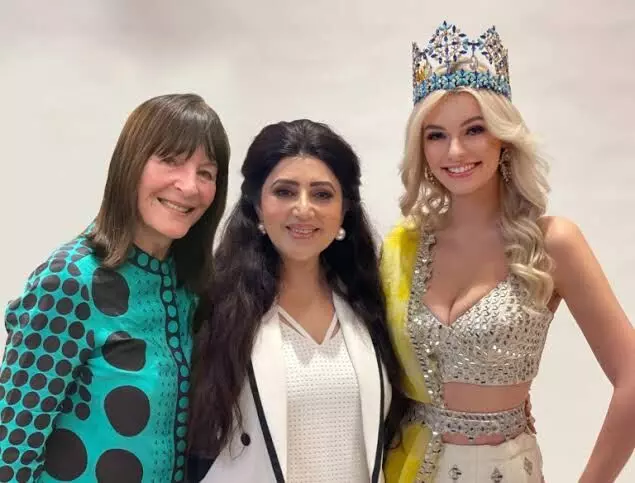Interview: From Pochampally to palaces, designer Archana Kochhar weaves Hyderabad into Miss World fashion
From Pochampally looms to royal motifs, Miss World fashion celebrates Telangana 's culture heritage, designer Archana Kochhar
By Anoushka Caroline Williams
Hyderabad: Miss World CEO Julia Morley with Indian designer Archana Kochhar and reigning Miss world Krystyna Pyszkova
Hyderabad: When the Miss World 2025 pageant chose Hyderabad, Telangana, as its grand stage, it wasn’t just an international event coming to India; it was an opportunity to showcase Telangana to the world.
And leading the sartorial charge was veteran designer Archana Kochhar, who saw the moment as far more than fashion. She saw it as a chance to place Telangana’s handloom legacy—particularly the iconic Pochampally Ikat—on a global pedestal.
Known for her deep respect for Indian textiles and transformative design sensibility, Kochhar took a bold and beautiful decision: to root her entire pageant wardrobe in the soul of Telangana’s weaves. From the looms of Pochampally to the heritage corridors of Hyderabad, every thread, motif, and silhouette was designed to echo the rich craftsmanship of the region while speaking fluently to an international audience.
But this wasn’t about draping tradition in cliché. Archana reimagined heritage with innovation—pairing centuries-old weaves with contemporary silhouettes, incorporating architectural elements from palaces and landmarks, and working directly with hundreds of artisans to craft over 240 unique looks for 120 contestants. The result? A celebration of Indian culture that was authentic, glamorous, and deeply rooted in the soil it came from.
In this exclusive interview with NewsMeter, Archana Kochhar takes us behind the scenes of her most ambitious project yet—sharing the inspiration, the intricacies, and the impact of bringing Telangana’s textile heritage to the Miss World stage.
Inspiration for design and concept
Q: What was your core inspiration behind using Pochampally for the Miss World pageant?
A: I’ve always believed in the power of Indian handlooms, and Pochampally Ikat is one of our finest. The turning point was when I visited a village near Pochampally and saw this exquisite fabric, the locals called ‘liquid gold.’ It had this surreal shimmer and richness that felt fit for royalty. That fabric became the centerpiece of our draping concept—not just for its beauty, but because gold in our culture is a symbol of good fortune and celebration.
Q: How did you balance traditional textile art with the glamour of an international beauty pageant?
A: It was important to retain the soul of the weave but modernise it through design. We used kallis—extra panels—to enhance comfort and flow. Then we experimented with structure and detailing: pearl hangings, threadwork motifs inspired by the Charminar, and pastel colour palettes for European contestants. It was about finding a global language without losing our identity.
Q: Was there a particular story or emotion you wanted the outfits to convey?
A: Yes. I wanted every piece to feel like a story. One of our silk collections had digital prints of the Chowmahalla Palace, with elements of local flora and fauna. Another collection drew from Hyderabad’s nickname as the ‘City of Pearls.’ Each contestant wasn’t just wearing a gown, she was wearing a slice of Hyderabad’s legacy.
Craftsmanship and collaboration
Q: Can you walk us through the process of working with the Pochampally weavers?
A: Meeting the weavers in person was transformative. Their hands carry generations of knowledge. One artisan showed me a weave that required 4 grams of real gold, and that level of intricacy and cultural symbolism was something I had to bring to the stage. We sourced materials directly and had open conversations about customisation for stage visibility and comfort.
Q: Were the artisans involved in the creative process?
A: Yes, absolutely. We didn’t want to impose—we wanted to collaborate. Their input on textures, patterns, and even draping methods helped us push creative boundaries while staying rooted in tradition. Their involvement added authenticity to the designs.
Q: How long did it take to execute the entire collection?
A: It was a massive effort. We had 640 artisans, 38 tailors, 7 master craftsmen and 48 assistants working around the clock. Designing 240 garments to suit 120 contestants, divided by continent and body type, was a logistical challenge—but also a beautiful, creative puzzle. It took months of coordination, but the result was worth every stitch.
Challenges and creativity
Q: What were the biggest challenges in adapting a heritage weave like Pochampally for a modern stage?
A: Scale and diversity. We had to design for women from across the world, each with different skin tones, body shapes and cultural aesthetics. We divided the contestants into four groups by continent and worked with silhouettes and colour palettes that enhanced their individuality while still tying into the central theme.
Q: Did you experiment with any new techniques or motifs for the pageant?
A: Definitely. One of our standout collections was the corded line, inspired by local architecture. We took traditional sarees, sourced from local vendors, and added structured cords to mimic the symmetry of palace archways and domes. In another, we printed motifs of the Chowmahalla Palace and Charminar on silk. We also played with gota and patti elements, all sourced from Charminar market, to keep the look rooted yet contemporary.
Q: How did you ensure the designs stood out amidst global competition?
A: By staying true to who we are. Everyone can do sequins and gowns, but only India can do this kind of textile storytelling. Our advantage was our history. We didn’t want every contestant in Ikat — so we showcased versatility through different weaves, embroidery, and hand-done detailing. The key was celebrating India without being repetitive.
Cultural representation
Q: Do you think this will spark renewed interest in Indian textiles among the global audience?
A: Absolutely. I think when you tell a story well, especially one rooted in real people and culture, it resonates far beyond borders.